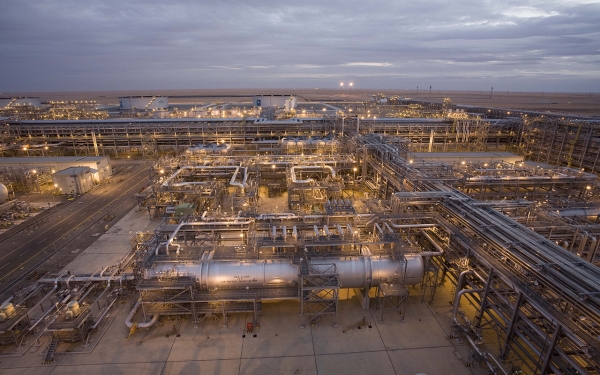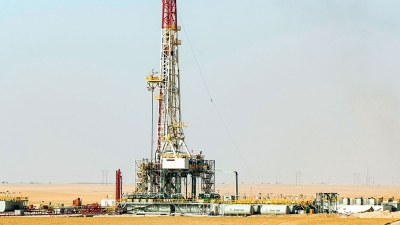

Khurais Oil Field, located in the Kingdom of Saudi Arabia, is adjacent to the world's largest oil field, the Ghawar oil Field, and produces an average of 1.2 million bbl of oil per day.
The Khurais Field was discovered in 1957, with a modest production not exceeding 190,000 bbl per day. By 1982, its production rate increased to three hundred thousand bbl per day through the addition of facilities for processing crude oil containing water. However, Saudi Aramco decided to halt operations in the field in 1993 due to its low production and declining pressure levels. This decision was reversed in January 2005 to meet the growing global demand.
The area of the Khurais Field is six thousand km², and it is located 150 km southeast of Riyadh. Production commenced on a pilot scale in 1963. The field comprises five main oil units, a water pumping facility, and an additional cogeneration facility.
Khurais Field production
The field produces concentrated crude oil, natural gas, and natural gas liquids using state-of-the-art techniques in field operations. It employs remote control technology for the massive oil field, which has over five hundred associated wells. Additionally, robot technology is used for daily inspection tasks, and artificial intelligence aids in decision-making.
Actual full capacity production in the Khurais project began on June 10, 2009, with the addition of 1.2 million bbl of light Arabian crude oil per day to the company's total production.
Development of Khurais Field operations
Saudi Aramco remains steadfast in advancing exploration and production technologies. This is evident in its investment in developing the world's largest smart oil field in Khurais , which also houses one of the globe's largest oil production facilities. Site facilities include industrial equipment and devices controlled automatically, in addition to artificial intelligence, machine learning, and big data analytics technologies.
The primary aim of developing the Khurais Field project is to increase the Kingdom's oil production by 1.2 million barrels per day, equivalent to the total production of some OPEC member countries. The purpose of this expansion is not solely to raise the Kingdom's production capacity but also to meet the escalating global demand for oil.
Khurais Field expansion
The completion of the Khurais Field expansion necessitated several procedures, including the expansion and modernization of the world's largest seawater treatment plants by 4.5 million bbl per day. It also entailed installing over 1,200 km of seawater distribution and injection pipelines, constructing a new water injection plant in Khurais , and expanding four other plants in Ayn Dar, Uthmaniyah, Hawiyah, and Haradh. Additionally, it involved building over nine hundred km of main oil pipelines, flowlines, and sub-lines for wells, as well as erecting over a thousand km of overhead power lines.
The expansion works in the field also included the installation of three thousand steel electrical towers, each ranging in height from twelve to twenty-seven m. It involved the construction of a central processing facility with four gas-oil separation plants, including facilities for oil concentration, two gas and condensate processing plants, production and storage facilities, various utilities, an electrical system with nine substations, hardware, and control systems. Additionally, it included the construction of transportation facilities, including over 170 km of pipelines of various sizes for transporting crude oil, natural gas liquids, refined products, and liquefied gas. Temporary housing facilities for approximately thirty thousand workers and permanent accommodations for 1,200 employees were built, along with industrial facilities and a local airport to support production operations.
Expansion Khurais Field implementation program
The project necessitated the implementation of a massive and highly intricate program involving the design, procurement, and installation of pipelines, expansion in seawater processing, facilities for crude oil and natural gas processing, as well as drilling oil production and water injection wells. It also involves extensive teamwork, as the project operates across fourteen sites worldwide, with the participation of over twenty-six key contractors, 106 subcontractors, and more than 28,000 employees. They managed to drill over three hundred wells a full ten months ahead of the initial three-year schedule, leveraging innovative engineering and operational methods.
Environmental reserve in Khurais Field
The Khurais project hosts an environmental reserve with an artificial lake spanning eight thousand m², filled with water to accommodate a diverse range of migratory birds and endemic species. The reserve area covers thirty-eight km², providing habitat for significant biodiversity that can withstand harsh desert conditions.
Khurais is protected by a three-m-high fence to prevent grazing by livestock. As the scorching summer ends and the mild winter weather begins, dew forms due to temperature drops. This transforms the delicate plants in Khurais into lush green areas. Following an environmental protection management survey of biodiversity, Khurais was recognized as an important biodiversity area. The dense native vegetation in the area provides habitat for at least twenty-two plant species, forty-two bird species, three reptile species, and seven mammal species.
In collaboration with the Environmental Protection Management, Khurais Production Management rehabilitated a portion of its fenced area by establishing three water ponds containing over 120 indigenous shrubs, three bird nesting towers, and two small natural stone shelters. This turned the area into a biodiversity hub within Khurais.
An attempt to sabotage the work of the Khurais Field
In 2019, Saudi Aramco facilities in Buqayq and Khurais were subjected to attacks that resulted in explosions, fires, and significant equipment damage. As a result of these attacks, Saudi Aramco's crude oil production temporarily decreased by approximately 54 percent, prompting the company to take several measures to mitigate the impact on its customers. These measures included tapping into its oil reserves outside of the Kingdom, supplying alternative types of crude oil, reducing shipments of liquid natural gas to some customers, and increasing production from other fields. On September 25, 2019, Saudi Aramco succeeded in restoring production to the same level it was before the attacks.
Technology in Khurais Field
Khurais harnesses the technologies of the Fourth Industrial Revolution. The Khurais facility was included in the Global Lighthouse Network by the World Economic Forum, making it the second facility under Saudi Aramco to join this list recognized by the World Economic Forum. This list includes the world’s leading manufacturing facilities in applying technologies of the Fourth Industrial Revolution. This recognition marks a new step confirming Saudi Aramco's success and technical leadership.
Khurais facility is one of ten facilities added to the Global Lighthouse Network in 2020, bringing the total number to fifty-four facilities from around the world. This comes after the inclusion of the Uthmaniyah Gas Plant in 2019, meaning that Saudi Aramco is one of only nine companies represented in the network with more than one facility, and it is also the only major energy company on the list.
Based on the developments in the Khurais project, it has garnered several awards, including the Saudi Aramco President's Excellence Award for 2020, as well as the King Abdulaziz Quality Award in its fifth edition in 2020.
Related quizzes

